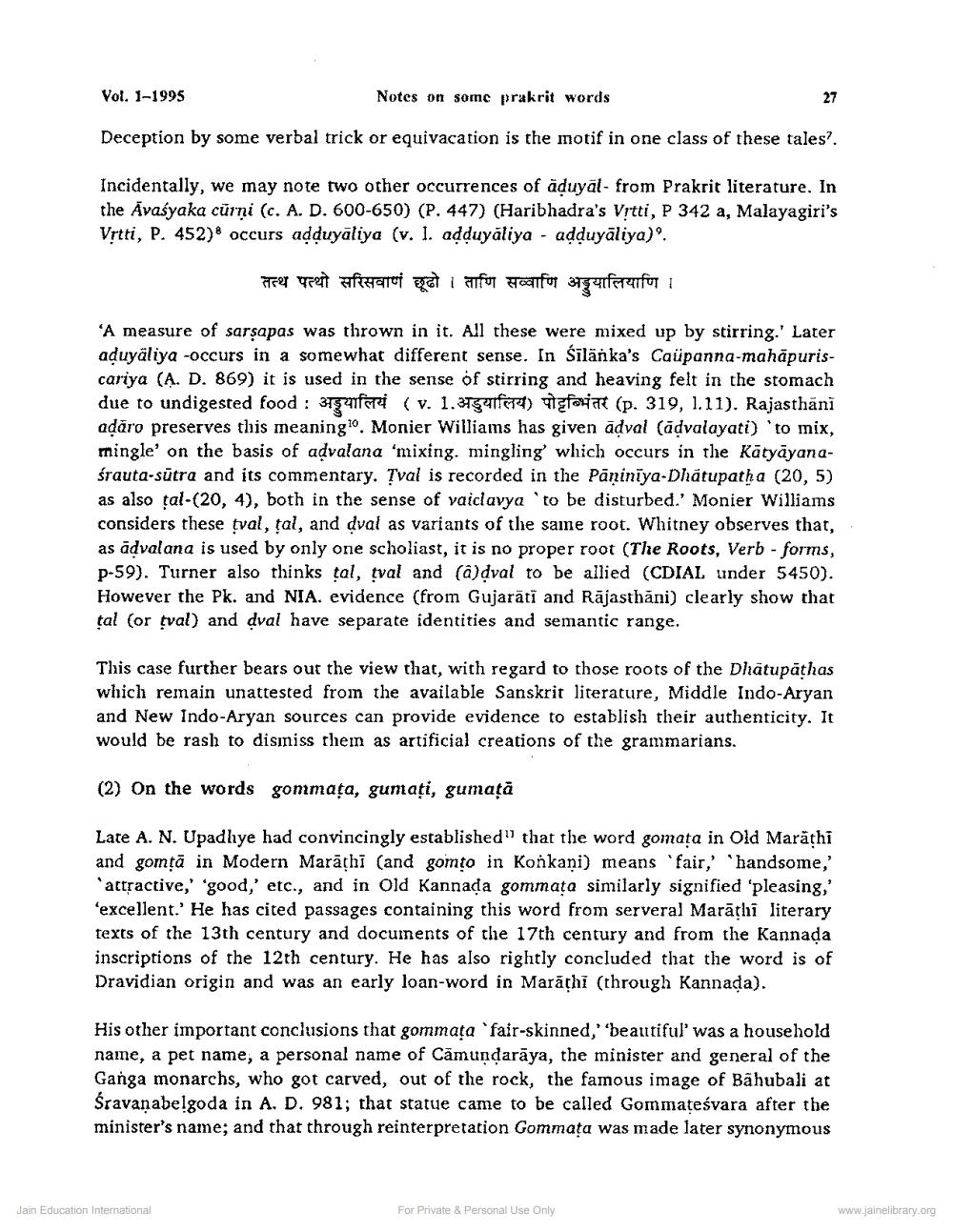Book Title: Notes on Some Prakrit Words Author(s): H C Bhayani Publisher: Z_Nirgrantha_1_022701.pdf and Nirgrantha_2_022702.pdf and Nirgrantha_3_022703.pdf View full book textPage 3
________________ Vol. 1-1995 Notes on some prakrit words Deception by some verbal trick or equivacation is the motif in one class of these tales? Incidentally, we may note two other occurrences of aduyāl - from Prakrit literature. In the Avašyaka cūrņi (c. A. D. 600-650) (P. 447) (Haribhadra's Vrtti, P 342 a, Malayagiri's Vrtti, P. 452) occurs adduyaliya (v. I. adduyaliya - adduyāliya)'. तत्थ पत्थो सरिसवाणं छूढो । ताणि सव्वाणि अड्यालियाणि । 'A measure of sarsapas was thrown in it. All these were mixed up by stirring.' Later aduyäliya -occurs in a somewhat different sense. In Sīlänka's Caüpanna-mahāpuriscariya (A. D. 869) it is used in the sense of stirring and heaving felt in the stomach due to undigested food : 375feri ( v. 1.37geft) więtojant (p. 319, 1.11). Rajasthāni adāro preserves this meaninglo. Monier Williams has given adval (advalayati) 'to mix, mingle' on the basis of advalana 'mixing. mingling which occurs in the Kātyāyanaśrauta-sūtra and its commentary. Tval is recorded in the Pāṇiniya-Dhátupatha (20,5) as also tal-(20, 4), both in the sense of vaiclavya 'to be disturbed.' Monier Williams considers these gval, tal, and dval as variants of the same root. Whitney observes that, as advalana is used by only one scholiast, it is no proper root (The Roots, Verb - forms, -59). Turner also thinks tal, tval and (adval to be allied (CDIAL under 5450). However the Pk. and NIA. evidence (from Gujarati and Rājasthāni) clearly show that tal (or ţval) and dval have separate identities and semantic range. This case further bears out the view that, with regard to those roots of the Dhatupāthas which remain unattested from the available Sanskrit literature, Middle Indo-Aryan and New Indo-Aryan sources can provide evidence to establish their authenticity. It would be rash to dismiss them as artificial creations of the grammarians. (2) On the words gommata, gumaţi, gumaţă Late A. N. Upadhye had convincingly established" that the word gomata in Old Marathi and gomtā in Modern Marathi (and gomto in Konkani) means 'fair,' 'handsome,' 'attractive,' 'good,' etc., and in Old Kannada gommata similarly signified 'pleasing,' 'excellent. He has cited passages containing this word from serveral Marathi literary texts of the 13th century and documents of the 17th century and from the Kannada inscriptions of the 12th century. He has also rightly concluded that the word is of Dravidian origin and was an early loan-word in Marathi (through Kannada). His other important conclusions that gommata 'fair-skinned,'beautiful was a household name, a pet name, a personal name of Cāmundarāya, the minister and general of the Ganga monarchs, who got carved, out of the rock, the famous image of Bahubali at Śravanabelgoda in A. D. 981; that statue came to be called Gommateśvara after the minister's name; and that through reinterpretation Gommata was made later synonymous Jain Education International For Private & Personal Use Only www.jainelibrary.orgPage Navigation
1 2 3 4 5 6 7 8 9 10 11 12 13 14
